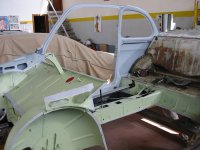no, i still haven't removed it..
i have the feeling i'm super slow at this stage.. putting the car apart was all so quick.. today i spent a few hours just removing that front bit that i had left from the floor, and clean around that zone. i have some questions about that, but let me tell you first what's it gonna be with the rest of the floor:
my next step will be to clean the inner sill as much as possible, and give it a few weld spots on the border of it from the inside of the car, so i can remove the welds made on the previous restoration. this basically allows me to keep the floor in place and stop whinning/worrying about how to remove the sill once the outter sill is in place. which means, i'll be able to follow the steps given by you both, on keeping the new outter sill aligned with the floor. (i understand the importance of doing it this way, but i'm getting really upset at the way the previous restoration was done, and i think you'll get a bit of that feeling when i show you the pics of today)
so, the pics:
please - please - help me understanding how is the floor from the tunnel supposed to end in the front, because i can only guess that there was some panel coming from under it, but i've no idea how's that supposed to look like. i see that twisted metal and it really makes me upset. (no, it wasn't me, in case you're wondering - comes from a previous resto, in which, clearly, to make it faster, they didn't care at all about it and just slammed the new floor on top of all the rusty panels. what didn't fit was put out in the worst way possible)
then there's this one.. i can understand that the panel from above, would have an L shape to, probably, provide support to the floor. there's a goot bit of it missing, but should be easy to make. what i don't understand is what's that panel doing under it. is it supposed to be there, or is that part of the old (original) floor, going under everything?
on this one i'm trying to show the hole on the wheel arch.. if it's not clear enough, please let me know so i draw a line around it.. why does this one worry me? it's behind the metal plate where the wheel is attached to. what would you guys do on it? (if you know how afraid i was of removing the sill, now imagine how much this one freaks me out)
and this one is basically another view on the whole thing. - i wonder what on earth hit the metal next to the left square.. it looks like when you hit a metal sheet with an axe..
sorry for the long post. i'm just upset. hope this all makes sense to you..










